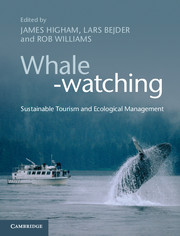Book contents
- Frontmatter
- Dedication
- Contents
- Acknowledgements
- List of contributors
- List of abbreviations
- 1 Tourism, cetaceans and sustainable development
- Part I The historical and contemporary contexts
- Part II Human dimensions of whale-watching
- 7 The whaling versus whale-watching debate
- 8 Iceland and the resumption of whaling
- 9 Green messengers or nature's spectacle
- 10 Whale-watching
- 11 What's in it for the whales?
- 12 Integrating traditional ecological knowledge and community engagement in marine mammal protected areas
- Part III Ecological dimensions of whale-watching
- Part IV Sustainable management: insights and issues
- Index
- Plate Section
- References
11 - What's in it for the whales?
Exploring the potential contribution of environmental interpretation to conservation
from Part II - Human dimensions of whale-watching
Published online by Cambridge University Press: 05 April 2014
- Frontmatter
- Dedication
- Contents
- Acknowledgements
- List of contributors
- List of abbreviations
- 1 Tourism, cetaceans and sustainable development
- Part I The historical and contemporary contexts
- Part II Human dimensions of whale-watching
- 7 The whaling versus whale-watching debate
- 8 Iceland and the resumption of whaling
- 9 Green messengers or nature's spectacle
- 10 Whale-watching
- 11 What's in it for the whales?
- 12 Integrating traditional ecological knowledge and community engagement in marine mammal protected areas
- Part III Ecological dimensions of whale-watching
- Part IV Sustainable management: insights and issues
- Index
- Plate Section
- References
Summary
Introduction
The question posed in the title to this chapter is deliberately provocative and it is a question which is seldom addressed in the multitude of studies and publications on whale-watching (cetacean-based tourism) world-wide. This is despite the fact it is now widely understood that whale-watching activities (especially those that occur from vessels and in the sea) are not benign (Higham & Bejder, 2008; Parsons, 2012). A wide range of research into the effects of vessel-based watching of whales and dolphins and swimming with wild cetaceans in differing locations and on different species has shown short-term behavioural impacts and, in some cases, long-term detrimental impacts (Wade et al., 2012).
Thus, it is clear that the risk of negative consequences for cetaceans from tourism activity exists (Bejder et al., 2006a), although it is questionable whether the degree of impact is equivalent across species (Wade et al., 2012). On the human side of the relationship a growing body of research has focused on the economic, social and, to a lesser degree, cultural impacts of whale-watching (Scarpaci et al., 2009). It is reported that this tourism activity has grown rapidly (Hoyt, 2001; Parsons, 2012) and that it generates significant economic revenue for operators and destinations which in turn supports communities, cultures and, in some cases, nations (O’Connor et al., 2009). Indeed, this volume has presented summaries of the above in some detail. That is, there are demonstrable negative impacts or, at the least, risks of negative consequences for cetaceans targeted for tourism; and conversely, that there are a range of benefits for the human side of the relationship (economic, social, cultural and personal). Given humans’ relationships with natural resources over history this is not surprising. The Judeo-Christian view of humans having dominion over nature and that nature's purpose is to provide benefit for humankind has become the dominant world-view through the twentieth century (Geisinger, 1999), and has provided a framework for debating the morality of killing whales (Gambell, 1990). Indeed, it is rare that development associated with human activity in the post-industrialized world has benefited nature and natural resources.
- Type
- Chapter
- Information
- Whale-watchingSustainable Tourism and Ecological Management, pp. 146 - 162Publisher: Cambridge University PressPrint publication year: 2014
References
- 7
- Cited by



